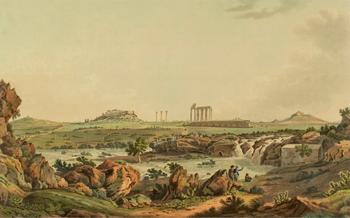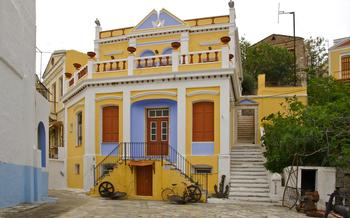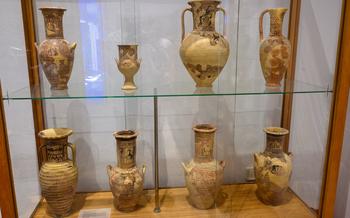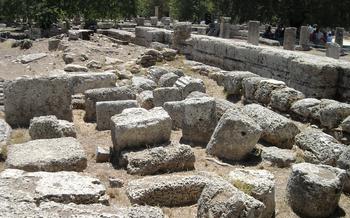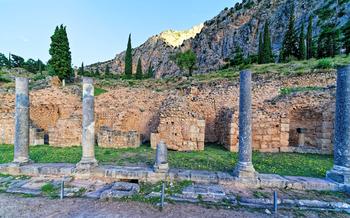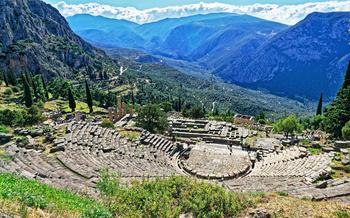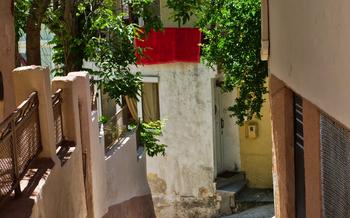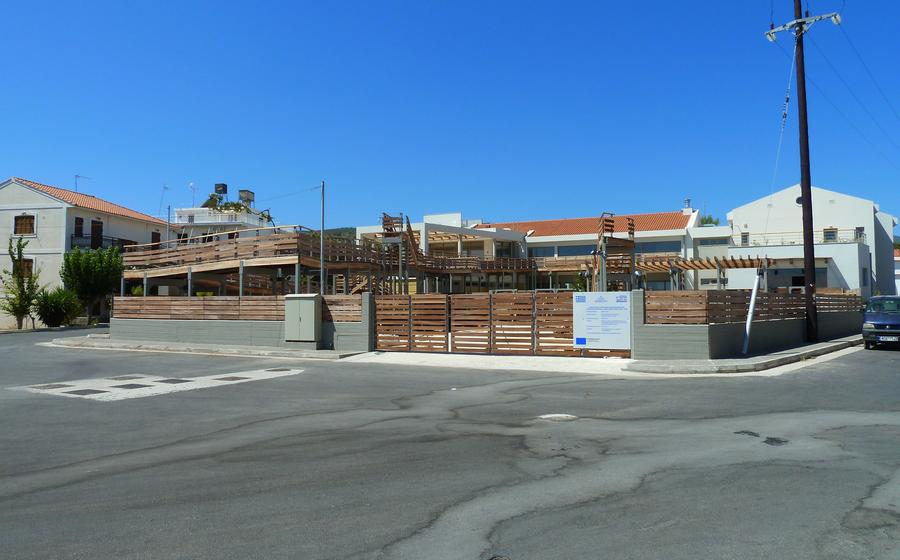
Samos Maritime Museum
- Samos Maritime Museum: A Journey Through Nautical History
- Maritime Splendors: Unveiling the Museum's Collection
- Navigating the Seas: Tools and Instruments
- The Art of Shipbuilding: A Legacy of Craftsmanship
- Naval Battles and Maritime Conflicts
- Women in Maritime History: Untold Stories
- Interactive Exhibits and Educational Programs
- Research and Conservation: Preserving Maritime Heritage
- The Museum as a Cultural Hub
- Accessibility and Visitor Services
- Photography and Social Media
- Local Cuisine and Culinary Delights
- Insider Tip: Hidden Gems and Off-the-Beaten-Path Experiences
Samos Maritime Museum: A Journey Through Nautical History
A treasure trove of maritime heritage, the Samos Maritime Museum stands as a testament to the island's deep-rooted seafaring traditions. Nestled on the picturesque Samos harbor, the museum offers a captivating journey through the annals of maritime history, showcasing an impressive collection of shipwrecks, nautical instruments, and artifacts that tell the story of Samos' rich seafaring past.
In ancient times, Samos was a renowned maritime power, playing a crucial role in trade and exploration throughout the Mediterranean Sea. This legacy is reflected in the museum's exhibits, which provide a glimpse into the island's shipbuilding prowess, naval battles, and cultural exchange. Visitors can marvel at ancient shipwrecks, decipher the secrets of navigational tools, and learn about the brave sailors who shaped Samos' maritime destiny.
The museum's stunning location, overlooking the shimmering waters of the harbor, adds to its allure. As you wander through the exhibits, the gentle sea breeze carries with it the whispers of history, inviting you to embark on a journey of discovery and wonder. The museum's collection is a testament to the enduring spirit of Samos' seafaring heritage, a legacy that continues to inspire and captivate visitors from around the world.
Maritime Splendors: Unveiling the Museum's Collection
The Samos Maritime Museum boasts a diverse and captivating collection that showcases the island's rich maritime heritage. Among the highlights are ancient shipwrecks that have been meticulously preserved and reconstructed, offering a glimpse into the seafaring prowess of ancient Samos. These shipwrecks reveal the intricate construction techniques and advanced navigational skills of the island's shipbuilders.
The museum also houses an impressive array of nautical instruments, including ancient compasses, astrolabes, and sextants. These instruments, which were essential for navigation in the days before GPS, demonstrate the ingenuity and resourcefulness of seafarers throughout history. Interactive displays and multimedia presentations bring these instruments to life, explaining their functions and illustrating how they were used to chart a course across the vast seas.
Maritime artifacts from various periods, such as anchors, pottery, and tools, further enrich the museum's collection. These artifacts provide insights into the daily lives of sailors, the types of goods that were traded, and the cultural exchanges that took place between Samos and other Mediterranean civilizations.
Temporary exhibitions and special events are regularly organized at the museum, showcasing specific aspects of maritime history or highlighting the work of contemporary artists and researchers. These events offer visitors an opportunity to delve deeper into the world of maritime heritage and engage with experts in the field.
Navigating the Seas: Tools and Instruments
The Samos Maritime Museum houses a fascinating collection of nautical instruments that tell the story of how seafarers have navigated the world's oceans for centuries. From ancient compasses to modern GPS systems, these tools have played a crucial role in enabling humans to explore and chart the vast expanse of the seas.
Among the highlights of the collection is an ancient astrolabe, a device used by astronomers and navigators to measure the altitude of celestial bodies above the horizon. This intricate instrument allowed seafarers to determine their latitude and longitude, essential for accurate navigation. The museum also boasts a collection of sextants, quadrants, and octants, instruments used to measure the angle between the horizon and a celestial body, enabling sailors to calculate their position.
In addition to these traditional tools, the museum showcases the evolution of navigation in the modern era, with exhibits on radio direction finders, radar systems, and GPS technology. These advancements have revolutionized navigation, making it possible for seafarers to determine their position with unprecedented accuracy.
The museum also tells the stories of famous navigators and their reliance on these tools. From the ancient Greek explorer Pytheas, who sailed beyond the Pillars of Hercules to explore the Atlantic Ocean, to the Portuguese navigator Vasco da Gama, who used astrolabes and other instruments to chart a route to India, these seafarers relied on their navigational skills and knowledge to achieve their ambitious goals.
The Art of Shipbuilding: A Legacy of Craftsmanship
Samos' rich shipbuilding tradition dates back centuries, with the island playing a significant role in the development of Mediterranean maritime history. Shipbuilding in Samos was renowned for its exquisite craftsmanship and the use of local materials, such as cypress and pine wood. Craftsmen employed traditional techniques passed down through generations, shaping the wood with precision and skill to create sturdy and seaworthy vessels. The island's shipyards were once a bustling hub of activity, with the sound of hammers and saws echoing through the air as skilled workers constructed boats of various sizes and designs.
Today, Samos' shipbuilding tradition continues, albeit on a smaller scale. Visitors can still witness the art of traditional boat building at local workshops, where craftsmen demonstrate their skills and knowledge. These workshops provide a glimpse into the island's maritime heritage and offer visitors the opportunity to purchase handmade souvenirs, such as miniature boats or decorative items crafted from wood. The preservation of this ancient craft ensures that Samos' shipbuilding legacy lives on, showcasing the island's unique contribution to maritime history.
Naval Battles and Maritime Conflicts
Samos has witnessed its fair share of naval battles and maritime conflicts throughout history. During the ancient Greek period, the island was a key battleground in the Peloponnesian War, with both the Athenian and Spartan fleets vying for control of the Aegean Sea. The Battle of Mycale, fought in 479 BC, saw the combined Greek forces decisively defeat the Persian navy, marking a turning point in the war.
In the Middle Ages, Samos was a target of pirate raids and invasions due to its strategic location. The island's fortifications, including the imposing Lycurgus Fortress, played a crucial role in repelling these attacks and protecting the local population.
During the 19th century, Samos was involved in the Greek War of Independence against the Ottoman Empire. The island's ships and sailors played an active role in the naval operations, contributing to the eventual liberation of Greece.
The museum's exhibits related to naval warfare include weapons, armor, and models of warships from different historical periods. Visitors can learn about the strategies and tactics employed by ancient Greek, Byzantine, and modern Greek naval commanders, gaining insights into the island's rich maritime history.
Women in Maritime History: Untold Stories
History books are often dominated by the tales of male seafarers, but the Samos Maritime Museum sheds light on the untold stories of women who played a crucial role in maritime history. From ancient seafaring goddesses like Amphitrite and Thetis, who ruled over the oceans and protected sailors, to female pirates like Artemisia I of Caria, who commanded a fleet of ships and raided coastal towns, women have left their mark on the maritime world.
The museum showcases artifacts and exhibits that highlight the diverse roles women played at sea. From ancient pottery depicting female sailors to medieval manuscripts describing female navigators, the museum challenges traditional narratives and celebrates the contributions of women to maritime culture.
One of the most fascinating exhibits is a collection of letters written by female passengers and crew members aboard migrant ships during the 19th and 20th centuries. These letters offer a glimpse into the challenges and triumphs of women who embarked on perilous journeys across the oceans in search of a better life.
The museum also recognizes the contributions of contemporary women in the maritime industry. Through interviews and oral histories, the museum sheds light on the experiences of female shipbuilders, marine biologists, and oceanographers, highlighting their dedication to preserving and protecting our oceans.
Interactive Exhibits and Educational Programs
The Samos Maritime Museum is not just a repository of artifacts; it's an interactive journey through maritime history, designed to engage visitors of all ages. Hands-on exhibits, multimedia displays, and virtual reality experiences bring the stories of Samos' seafaring past to life, making learning an immersive and enjoyable experience.
For school groups and families, the museum offers tailored educational programs that foster curiosity and a deeper understanding of maritime heritage. Through interactive workshops, storytelling sessions, and hands-on activities, children can explore the wonders of the sea and discover the fascinating world of seafarers, shipbuilders, and explorers.
The museum also hosts regular lectures, workshops, and special events that delve into specific aspects of maritime history and culture. These events provide a platform for experts, researchers, and enthusiasts to share their knowledge and engage with the public, creating a vibrant community of maritime enthusiasts.
Research and Conservation: Preserving Maritime Heritage
The Samos Maritime Museum is not just a repository of artifacts; it is also an active center for maritime research and conservation. The museum collaborates with universities, research institutions, and maritime organizations to advance knowledge and protect underwater cultural heritage. Researchers from around the world come to Samos to study the museum's collection and to participate in ongoing research projects.
One of the most important research areas is the study of ancient shipwrecks. The waters around Samos are home to a wealth of shipwrecks, dating from the Bronze Age to the Byzantine period. The museum's team of archaeologists and conservators works tirelessly to document, excavate, and preserve these underwater treasures.
The museum also plays a vital role in conserving maritime artifacts. The museum's conservation lab is equipped with state-of-the-art facilities for the conservation and restoration of artifacts made from a variety of materials, including wood, metal, ceramic, and glass. The museum's conservators work closely with researchers to ensure that artifacts are properly preserved and displayed for future generations.
Visitors to the Samos Maritime Museum can learn about the museum's research and conservation efforts through interactive exhibits and educational programs. The museum also offers opportunities for visitors to get involved in research or volunteer activities, such as participating in underwater surveys or helping to clean and catalog artifacts.
The Museum as a Cultural Hub
The Samos Maritime Museum is not just a repository of maritime history; it is also a vibrant cultural hub that fosters exchange and dialogue through a variety of events and exhibitions. The museum collaborates with local artists, musicians, and performers to create immersive experiences that celebrate maritime culture. From art exhibitions showcasing maritime-themed works to traditional music concerts and theatrical performances, the museum provides a platform for local talent to share their creativity and passion for the sea.
In addition, the museum hosts festivals, workshops, and educational programs that bring together people from diverse backgrounds to learn about and appreciate maritime heritage. These events often feature interactive activities, hands-on demonstrations, and storytelling sessions that make maritime history come alive for visitors of all ages.
The museum's commitment to cultural exchange extends beyond its walls. It collaborates with other museums, cultural institutions, and universities around the world to organize joint exhibitions, research projects, and educational initiatives. These partnerships promote cross-cultural understanding and foster a global community of maritime enthusiasts.
By embracing its role as a cultural hub, the Samos Maritime Museum contributes to the vibrant cultural scene of Samos and enriches the island's tourism experience. Visitors are not just treated to a collection of artifacts; they are invited to immerse themselves in the living heritage of the sea and engage with the local community in meaningful ways.
Accessibility and Visitor Services
The Samos Maritime Museum is committed to providing an inclusive and accessible experience for all visitors. Wheelchair ramps and elevators ensure that the museum is fully accessible for visitors with disabilities. Audio guides in multiple languages are available to assist visitors from diverse backgrounds in understanding the exhibits. The museum also offers guided tours in multiple languages, ensuring that visitors can fully appreciate the museum's exhibits.
For visitors with limited mobility or special needs, the museum staff is always on hand to provide assistance. Restrooms are equipped with accessible features, and there is a designated area for visitors to rest and relax. The museum also offers a variety of amenities such as a gift shop, café, and resting areas for visitors to enjoy their time at the museum.
To ensure a smooth and enjoyable visit, visitors are encouraged to contact the museum in advance if they have any specific accessibility requirements. The museum staff will be happy to assist in making arrangements to accommodate individual needs.
Photography and Social Media
The Samos Maritime Museum encourages visitors to capture and share their experiences through photography and social media. Visitors are allowed to take photos of the exhibits and the museum's surroundings, provided they do not use flash or tripods. The museum also welcomes visitors to share their photos and stories on social media, using the designated hashtags or geotags.
The museum actively engages with its online audience through social media campaigns and initiatives. Visitors are encouraged to follow the museum's social media accounts to stay updated on upcoming events, exhibitions, and special programs. The museum also shares behind-the-scenes photos, videos, and stories, offering a glimpse into the work that goes on behind the scenes to preserve and showcase Samos' maritime heritage.
For those who love to take stunning photos, the Samos Maritime Museum offers plenty of opportunities to capture unique and memorable shots. The museum's exhibits are beautifully displayed and provide a visually appealing backdrop for photography. The museum's location overlooking the picturesque Samos harbor also offers stunning views that can be captured in your photos.
So, don't forget to bring your camera when you visit the Samos Maritime Museum and share your experiences with the world through photography and social media. Use the designated hashtags or geotags to connect with other museum-goers and join the online community that celebrates Samos' rich maritime heritage.
Local Cuisine and Culinary Delights
After exploring the fascinating world of maritime history at the Samos Maritime Museum, indulge in the island's culinary delights, which are deeply intertwined with its seafaring heritage. Savor the freshest seafood dishes at traditional Greek tavernas or restaurants lining the picturesque harbor. Don't miss the chance to try "souma," a local anise-flavored spirit, and "samosa," a sweet pastry that embodies the island's maritime essence.
For an authentic culinary experience, venture into the heart of Samos and seek out family-run tavernas that have been passed down through generations. These hidden gems often serve up mouthwatering dishes made with locally sourced ingredients and traditional recipes. Ask the locals for their recommendations and be prepared to be delighted by the flavors and aromas of Samos' maritime cuisine.
Whether it's grilled octopus, succulent shrimp, or aromatic fish stews, the culinary offerings of Samos are a testament to the island's rich maritime heritage. Savor each bite as you soak in the vibrant atmosphere of a traditional taverna, surrounded by the sounds of clinking glasses and lively conversations.
And as you indulge in these culinary delights, remember that you are not just satisfying your taste buds but also supporting the local community and preserving the island's culinary traditions. So, embrace the flavors of Samos and let your taste buds take you on a journey through its maritime history.
Insider Tip: Hidden Gems and Off-the-Beaten-Path Experiences
Beyond the walls of the Samos Maritime Museum, the island offers a treasure trove of hidden gems and off-the-beaten-path experiences for those who seek to delve deeper into its maritime heritage. Venture off the main tourist trails and discover secluded beaches where ancient shipwrecks lie beneath the crystal-clear waters, waiting to be explored by curious divers. Visit charming fishing villages like Kokkari or Ormos Marathokampou, where the locals still uphold traditional boat-building techniques and share stories of their seafaring ancestors. Don't miss the opportunity to attend the annual Samos Sailing Week, a vibrant festival that brings together sailing enthusiasts from around the world and showcases the island's rich maritime traditions. Whether you're an avid sailor, a history buff, or simply someone who appreciates the beauty of the sea, Samos offers a myriad of hidden maritime wonders waiting to be discovered.



